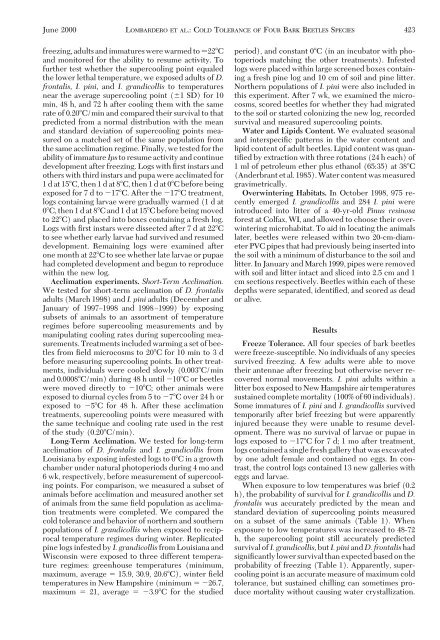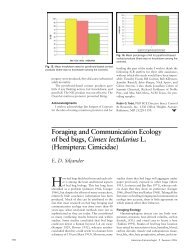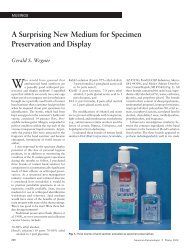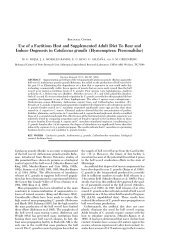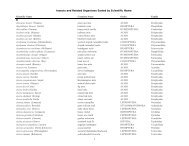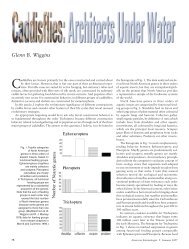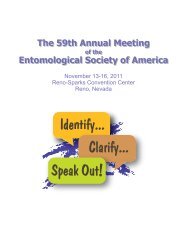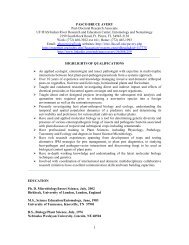Cold Tolerance of Four Species of Bark Beetle (Coleoptera ...
Cold Tolerance of Four Species of Bark Beetle (Coleoptera ...
Cold Tolerance of Four Species of Bark Beetle (Coleoptera ...
You also want an ePaper? Increase the reach of your titles
YUMPU automatically turns print PDFs into web optimized ePapers that Google loves.
June 2000 LOMBARDERO ET AL.: COLD TOLERANCE OF FOUR BARK BEETLES SPECIES 423<br />
freezing, adults and immatures were warmed to 22C<br />
and monitored for the ability to resume activity. To<br />
further test whether the supercooling point equaled<br />
the lower lethal temperature, we exposed adults <strong>of</strong> D.<br />
frontalis, I. pini, and I. grandicollis to temperatures<br />
near the average supercooling point (1 SD) for 10<br />
min, 48 h, and 72 h after cooling them with the same<br />
rate <strong>of</strong> 0.20C/min and compared their survival to that<br />
predicted from a normal distribution with the mean<br />
and standard deviation <strong>of</strong> supercooling points measured<br />
on a matched set <strong>of</strong> the same population from<br />
the same acclimation regime. Finally, we tested for the<br />
ability <strong>of</strong> immature Ips to resume activity and continue<br />
development after freezing. Logs with Þrst instars and<br />
others with third instars and pupa were acclimated for<br />
1dat15C,then1dat8C,then1dat0C before being<br />
exposed for7dto17C. After the 17C treatment,<br />
logs containing larvae were gradually warmed (1 d at<br />
0C,then1dat8Cand1dat15C before being moved<br />
to 22C) and placed into boxes containing a fresh log.<br />
Logs with Þrst instars were dissected after7dat22C<br />
to see whether early larvae had survived and resumed<br />
development. Remaining logs were examined after<br />
one month at 22C to see whether late larvae or pupae<br />
had completed development and begun to reproduce<br />
within the new log.<br />
Acclimation experiments. Short-Term Acclimation.<br />
We tested for short-term acclimation <strong>of</strong> D. frontalis<br />
adults (March 1998) and I. pini adults (December and<br />
January <strong>of</strong> 1997Ð1998 and 1998Ð1999) by exposing<br />
subsets <strong>of</strong> animals to an assortment <strong>of</strong> temperature<br />
regimes before supercooling measurements and by<br />
manipulating cooling rates during supercooling measurements.<br />
Treatments included warming a set <strong>of</strong> beetles<br />
from Þeld microcosms to 20C for 10 min to 3 d<br />
before measuring supercooling points. In other treatments,<br />
individuals were cooled slowly (0.003C/min<br />
and 0.0008C/min) during 48 h until 10C or beetles<br />
were moved directly to 10C; other animals were<br />
exposed to diurnal cycles from 5 to 7C over 24 h or<br />
exposed to 5C for 48 h. After these acclimation<br />
treatments, supercooling points were measured with<br />
the same technique and cooling rate used in the rest<br />
<strong>of</strong> the study (0.20C/min).<br />
Long-Term Acclimation. We tested for long-term<br />
acclimation <strong>of</strong> D. frontalis and I. grandicollis from<br />
Louisiana by exposing infested logs to 0C in a growth<br />
chamber under natural photoperiods during 4 mo and<br />
6 wk, respectively, before measurement <strong>of</strong> supercooling<br />
points. For comparison, we measured a subset <strong>of</strong><br />
animals before acclimation and measured another set<br />
<strong>of</strong> animals from the same Þeld population as acclimation<br />
treatments were completed. We compared the<br />
cold tolerance and behavior <strong>of</strong> northern and southern<br />
populations <strong>of</strong> I. grandicollis when exposed to reciprocal<br />
temperature regimes during winter. Replicated<br />
pine logs infested by I. grandicollis from Louisiana and<br />
Wisconsin were exposed to three different temperature<br />
regimes: greenhouse temperatures (minimum,<br />
maximum, average 15.9, 30.9, 20.6C), winter Þeld<br />
temperatures in New Hampshire (minimum 26.7,<br />
maximum 21, average 3.9C for the studied<br />
period), and constant 0C (in an incubator with photoperiods<br />
matching the other treatments). Infested<br />
logs were placed within large screened boxes containing<br />
a fresh pine log and 10 cm <strong>of</strong> soil and pine litter.<br />
Northern populations <strong>of</strong> I. pini were also included in<br />
this experiment. After 7 wk, we examined the microcosms,<br />
scored beetles for whether they had migrated<br />
to the soil or started colonizing the new log, recorded<br />
survival and measured supercooling points.<br />
Water and Lipids Content. We evaluated seasonal<br />
and interspeciÞc patterns in the water content and<br />
lipid content <strong>of</strong> adult beetles. Lipid content was quantiÞed<br />
by extraction with three rotations (24 h each) <strong>of</strong><br />
1 ml <strong>of</strong> petroleum ether plus ethanol (65:35) at 38C<br />
(Anderbrant et al. 1985). Water content was measured<br />
gravimetrically.<br />
Overwintering Habitats. In October 1998, 975 recently<br />
emerged I. grandicollis and 284 I. pini were<br />
introduced into litter <strong>of</strong> a 40-yr-old Pinus resinosa<br />
forest at Colfax, WI, and allowed to choose their overwintering<br />
microhabitat. To aid in locating the animals<br />
later, beetles were released within two 20-cm-diameter<br />
PVC pipes that had previously being inserted into<br />
the soil with a minimum <strong>of</strong> disturbance to the soil and<br />
litter. In January and March 1999, pipes were removed<br />
with soil and litter intact and sliced into 2.5 cm and 1<br />
cm sections respectively. <strong>Beetle</strong>s within each <strong>of</strong> these<br />
depths were separated, identiÞed, and scored as dead<br />
or alive.<br />
Results<br />
Freeze <strong>Tolerance</strong>. All four species <strong>of</strong> bark beetles<br />
were freeze-susceptible. No individuals <strong>of</strong> any species<br />
survived freezing. A few adults were able to move<br />
their antennae after freezing but otherwise never recovered<br />
normal movements. I. pini adults within a<br />
litter box exposed to New Hampshire air temperatures<br />
sustained complete mortality (100% <strong>of</strong> 60 individuals).<br />
Some immatures <strong>of</strong> I. pini and I. grandicollis survived<br />
temporarily after brief freezing but were apparently<br />
injured because they were unable to resume development.<br />
There was no survival <strong>of</strong> larvae or pupae in<br />
logs exposed to 17C for 7 d; 1 mo after treatment,<br />
logs contained a single fresh gallery that was excavated<br />
by one adult female and contained no eggs. In contrast,<br />
the control logs contained 13 new galleries with<br />
eggs and larvae.<br />
When exposure to low temperatures was brief (0.2<br />
h), the probability <strong>of</strong> survival for I. grandicollis and D.<br />
frontalis was accurately predicted by the mean and<br />
standard deviation <strong>of</strong> supercooling points measured<br />
on a subset <strong>of</strong> the same animals (Table 1). When<br />
exposure to low temperatures was increased to 48-72<br />
h, the supercooling point still accurately predicted<br />
survival <strong>of</strong> I. grandicollis, but I. pini and D. frontalis had<br />
signiÞcantly lower survival than expected based on the<br />
probability <strong>of</strong> freezing (Table 1). Apparently, supercooling<br />
point is an accurate measure <strong>of</strong> maximum cold<br />
tolerance, but sustained chilling can sometimes produce<br />
mortality without causing water crystallization.


